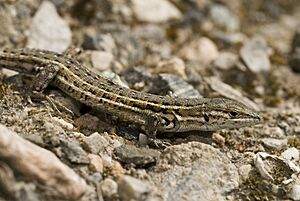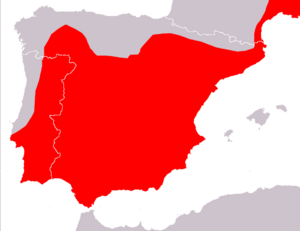Spanish psammodromus facts for kids
Quick facts for kids Spanish psammodromus |
|
|---|---|
 |
|
| Conservation status | |
| Scientific classification | |
| Genus: |
Psammodromus
|
| Species: |
hispanicus
|
 |
|
The Spanish psammodromus (scientific name: Psammodromus hispanicus) is a small lizard. It belongs to the Lacertidae family, which includes many types of lizards.
You can find it in France, Portugal, and Spain. It likes to live in warm, dry places. These include areas with Mediterranean bushes, grassy fields, sandy beaches, and even gardens or farms. Sadly, its home is sometimes lost, which is a problem for this lizard.
About the Spanish Psammodromus
The Spanish psammodromus was first described in 1826 by a scientist named Fitzinger. Its scientific name, Psammodromus hispanicus, has a special meaning. Psammodromus comes from Greek words meaning 'sand' and 'to run'. hispanicus is a Latin word meaning 'from Spain'. So, it's like saying "the sand runner from Spain"!
What Does It Look Like?
The Spanish psammodromus is one of the smallest lizards you can find in France. It has special patterns on its body that make it unique.
Size of the Lizard
When they hatch, baby lizards are very tiny, only about 20 to 25 millimeters (less than an inch) long. Adult lizards can grow to about 50 millimeters (2 inches) long. Their tail is super long, about 1.5 times their body size! This means a full-grown Spanish psammodromus can be around 120 to 130 millimeters (about 5 inches) long from nose to tail tip.
Body Shape
These lizards have a slim and long body. They have a small, pointed head and long back legs. Their tail is very thin and long. Their scales are rough and overlap, giving them a bumpy look, a bit like their relative, the large psammodromus.
Colors and Patterns
Spanish psammodromus lizards often have dark brown, olive-brown, or rusty red colors. They have many lighter, uneven spots and lines on their sides. Along their back, you might see small white streaks. These white streaks usually have a darker color around them. Their belly is a yellowish color.
Where Do They Live?
You can find these lizards across most of the Iberian peninsula. This area includes Spain and Portugal. However, they don't live along the northern coast or in the high Pyrenees mountains. In France, they only live along the Mediterranean coast.
Different Types
There are two main types, or subspecies, of the Spanish psammodromus:
- edwarsianus: This type is found in France.
- hispanicus: This type lives in the Iberian peninsula.
How Are Males and Females Different?
Female lizards look a bit bigger in the spring. This is because they are carrying eggs inside them.
Life in Different Seasons
Just like the difference in spring, females are larger when they are carrying eggs.
Lizard Life and Habits
What Do They Eat?
Spanish psammodromus lizards mainly eat small insects and spiders.
How Do They Protect Themselves?
If something scares them, these lizards quickly run into nearby bushes or plants to hide. If they get caught, they might make a small squeaking sound. But don't worry, they never bite!
Reproduction and Life Cycle
Lizards start to breed in the spring after they wake up from their winter sleep (hibernation). After just a few weeks, the female lays about 2 to 8 eggs. She finds a warm, damp spot for them, often under piles of hay or rotting wood. The eggs stay there for about 8 weeks before the babies hatch. A female can lay eggs up to two times in one year.
How Long Do They Live?
The Spanish psammodromus usually lives for only 2 to 3 years. Many of them even die after their first breeding season. They become old enough to have babies when they are just one year old.
Daily Habits
These lizards are active during the day. If you see one, it's often running quickly from one group of plants to another.
Their Home Environment
Habitat and Altitude
You can find these lizards living in places up to 1500 meters (about 4900 feet) high. They like dry, open areas around the Mediterranean Sea. These places usually have lots of rocks and loose soil, like sand, nearby.
Who Are Their Predators?
Many animals hunt and eat the Spanish psammodromus. These include birds, large insects, snakes, and other small mammals.


